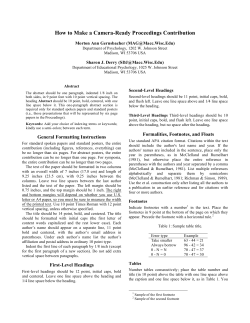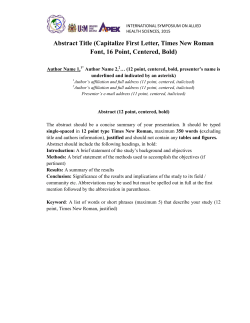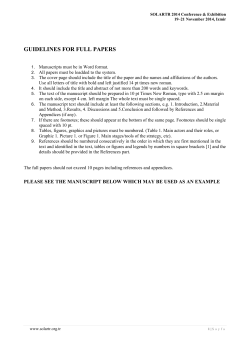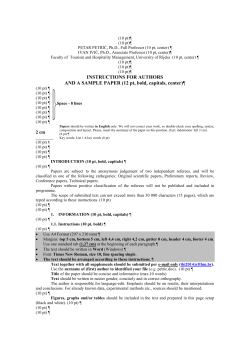
Grey-water reuse - a potential strategy for wastewater control in Vietnam
Grey-water reuse - a potential strategy for wastewater control in Vietnam Huyen T.T. DANG1 1 PhD, Water Supply and Sanitation Department, Institute of Environmental Science and Engineering, Hanoi University of Civil Engineering, Vietnam huyendangctn@gmail.com ABSTRACT The paper title should be in 18 pt bold face type of Helvetica or Arial font in uppercase, aligned right. The author names should be 2 lines (12 pt) below the paper title. The abstract should provide a summary of the key findings of the paper with 200 words. The word ABSTRACT should be in 12 pt bold face italicized type of Times New Roman font, 2 lines (12 pt) below the author’s affiliated organization, aligned left. There should be 1 line (12 pt) between the word ABSTRACT and the abstract itself. The body of the abstract should be fully justified, same as the body of the text of the paper, in 12 pt italicized type of Times New Roman font. Below the abstract, there should be 1line (12 pt), followed by the word keywords in bold, italic, Times New Roman font, 12 pt. After the word keywords, please include up to 5 keywords which describe your paper’s contents in italic, Times New Roman, 12 pt. Keywords: all small character (except a proper noun) 1. INTRODUCTION Effectively, we are asking each author to provide a camera-ready paper that will look pretty much like the final proceedings. This way, authors can make sure that the final product will be what they want, and we will not have to re-format material. The instructions herein are therefore rather complete. The maximum number of pages of the manuscript is limited to 10. The maximum file upload size 10 Megabytes. Please email an electronic copy in MS-Word and PDF file to the Secretariat (icus@iis.u-tokyo.ac.jp) by 31 August 2014. 2. TEXT 2.1 Text The text should be Times New Roman (including figure captions, tables, etc). The body of the text should be in 12 pt type, single-spaced. A single column will be used. 2.2 Header and footer November 2014, Yangon, Myanmar Please use the given header and footer format as it is; only edit your paper title. The font size of header and footer is 11 pt italicized type Times New Roman font. You do not need to edit the page number. 3. HEADINGS First order headings like the one above are in 12 pt bold face with uppercase, 2 lines (12 pt) below the preceding paragraph, and 1 line (12 pt) above the succeeding text. Please do not use the automatic outline heading facility in your word processor because the numbers frequently do not transfer correctly. In other words, type the heading number in, rather than allow the word processor to generate it automatically. 3.1 Second order headings Second order headings like the one above are in 12 pt bold face, 1 lines (12 pt) below the preceding paragraph and one line (12 pt) above the succeeding text. 3.1.1 Third order headings These should not really be needed, but if they are, please use the format above. That is, 12 pt bold faces. The heading should be 1 line (12 pt) below the preceding text, and immediately above the succeeding text. 4. PAGE SIZE AND LAYOUT The proceedings volume will be on A4 paper, with top margin 2.5 cm, bottom 2.8 cm, inside 6 cm, outside 2 cm and header & footer margin 1.27 cm. Please set your margins accordingly, or you could use this document as a template, into which you cut and paste. Use ‘Mirror margins’ in the options given for multipages in page setup menu. It is required for both side printing of the final proceedings as the inside and outside margins are not same in this proceedings volume. When a heading comes at the bottom of a page please try to adjust the length of preceding paragraphs, by slight rewriting, so that the title appears at the top of the next page; it is often possible to shorten a paragraph with only one word on the final line. You might also be able to resize a figure. Otherwise, add extra line spacing above headings. 5. ILLUSTRATIONS When preparing illustrations, please bear in mind the page size, the space (10 pages maximum) available, and the need to ensure legibility. Please provide all illustrations at the intended final size; if this is not possible, ensure that they will be legible when reduced in size. 5.1 Specific details New Technologies for Urban Safety of Mega Cities in Asia Illustrations should have sharp black lines and text. Avoid grey tones, which often do not reproduce well, and instead use line or dot shading. If you use photographs, it would be desirable for them to be screened. Maps should have a bar scale and north point on them. All lettering should be at least 8 pt (2 mm high), and Arial font is preferred for clarity. 5.2 Layout of illustrations You are requested to import illustrations into your paper as scanned objects, graphs imported from Excel etc. (Figure 1). It tends to be a lot easier if you locate illustrations at the top of a page, or following a paragraph. The illustration should follow the first reference to it in the text. 5.3 Figure captions (including photos) Figure captions should be in 12 pt and centered below the illustration. If the caption is more than one line, indent the second and following lines below the first word of the text. Figure 1: Text box used to locate an illustration 6. TABLES Please place tables in their intended location in the text (Table 1). Table 1: Some comments on tables Topic Style Font Heading Spacing Comment Like this. (List 3, for MS-Word users) 12 pt Times New Roman Above the table, in bold face One line (12 pt) above and below 7. UNITS AND SYMBOLS Please use metric units. Please define terms and symbols the first time that they are used in the text. Specify the dimensions of variables in tables and on graph axes (e.g. Water depth (cm)). 7.1 Equations Please centre equations, with 1 line (12 pt) above and below, as follows (equation 1): Y = a + bX Your paper title (1) November 2014, Yangon, Myanmar Each equation should be numbered, right-justified. (It is easier to right-justify a line with a simple equation on it, and use tabs to space the equation across to the centre. For a complex equation, use a text-box). REFERENCES No index number is required in the title “REFERENCE”, which should be bold face type in uppercase. References in the text should follow the standard format (Brown, 1997). As Brown (1997) suggested, they should be in the format shown immediately below. References are in 12 pt type. Journal titles should be in full. Journal and book titles should be italicised. Multiple authors should all be listed. Brown, A., 1997. How to format references. Unpublished report, NIWA, Christchurch, New Zealand. Davoren, A., and Mosley, M. P., 1986. Observations of bedload movement, bar development and sediment supply in the braided Ohau River. Earth Surface Processes & Landforms 11, 643-652. Mosley, M. P., 1979. Sediment sources in the Harper-Avoca Catchment. Forest Research Technical Paper 68, New Zealand Forest Service, Wellington. Mosley, M. P., 1997. Motu River. In Jayawardena, A. W., Takeuchi, K., and Machbub, B. (editors), Catalogue of Rivers for Southeast Asia and the Pacific, Vol 2, UNESCOIHP Regional Steering Committee, Jakarta, 226-235. Schumm, S. A., Mosley, M. P., and Weaver, W. E., 1987. Experimental geomorphology: the study of small landforms. John Wiley, New York. New Technologies for Urban Safety of Mega Cities in Asia
© Copyright 2025




















